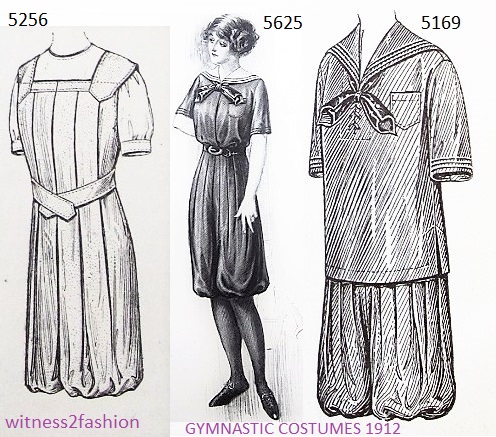
Three gymnastic costumes for women and girls, Butterick patterns from Delineator magazine, 1912.
There were no gymnastic competitions for women in the 1912 Olympics, and it would be hard to imagine Simone Biles (or anyone else) spinning through the air in one of these “Gymnastic Costumes” from 1912. [If you click on that link you’ll have to watch a short commercial first, but I can’t stop marvelling at the things this young woman can do. Uneven bars isn’t even her best event!]
For some reason, Butterick offered three different women’s gym “costumes” in 1912.
January 1912: Butterick 5169
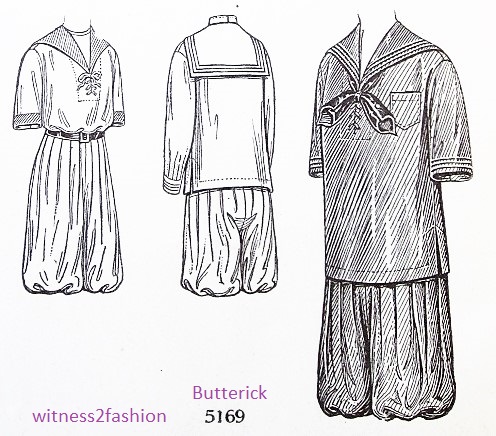
Butterick gymnastic costume 5169 is based on the classic middy blouse. Delineator, January 1912, p. 46.
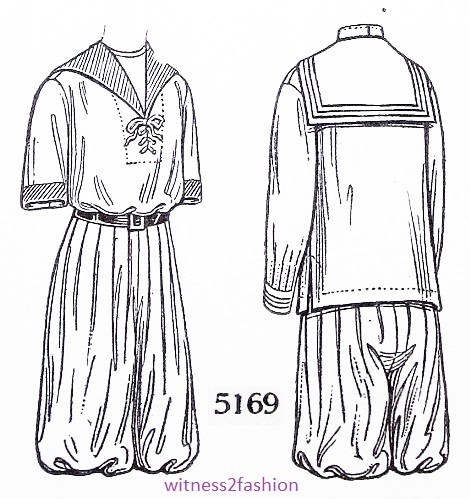
Details and back view, Butterick 5169. The bloomers (pleated or gathered) are separate.
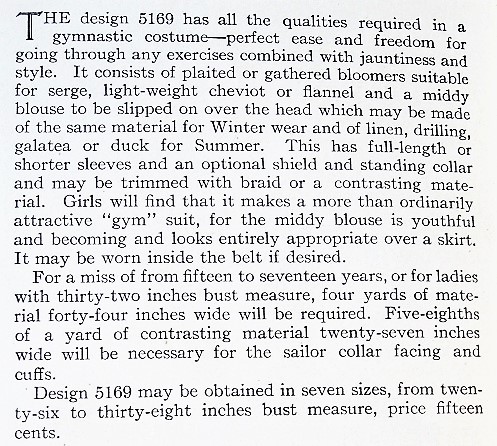
For girls, misses, and women, in seven sizes for bust measure from 26 to 38 inches. The bloomers and middy could be made in matching fabric for winter, or a cooler summer middy could be made of linen, etc., and worn with a skirt.
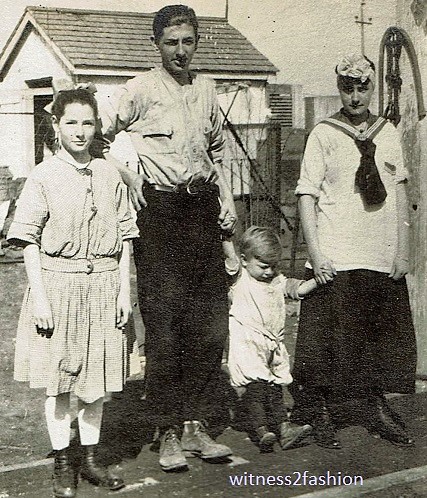
Four children, about 1916. My aunt, at right, wears a middy and a skirt.
March 1912: Butterick 5256
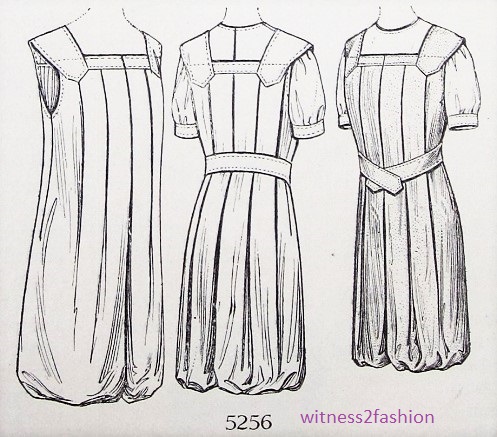
One piece gymnastic costume; the under-blouse is called a guimpe. Butterick 5256, March 1912.
Here’s a close-up of the stitching:
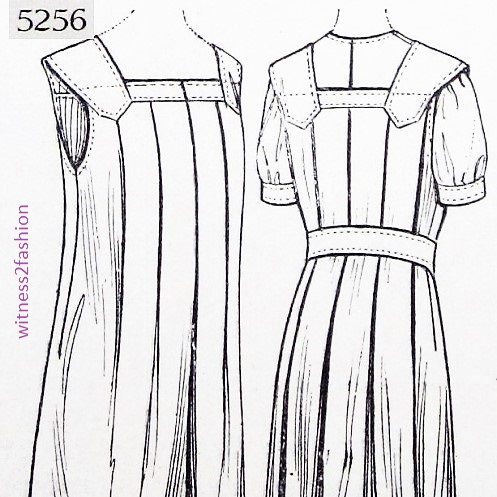
Butterick 5256 is sleeveless, but worn with an easily washable guimpe under it.
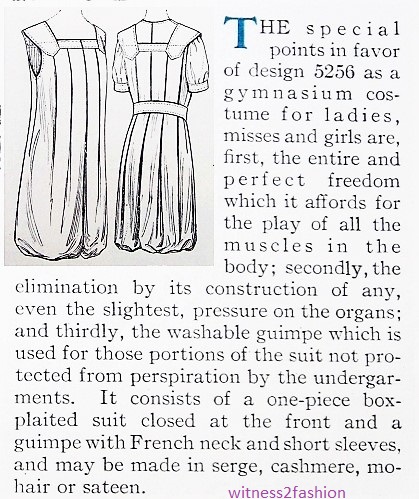
Top text for Butterick 5256, a gym suit for “ladies, misses, and girls. March 1912.

This gymnastic costume was available in nine sizes, from 26 to 42 inch bust measure. It does not have a fitted waist, so there is not even “the slightest pressure on the organs.”
September 1912: Butterick 5625
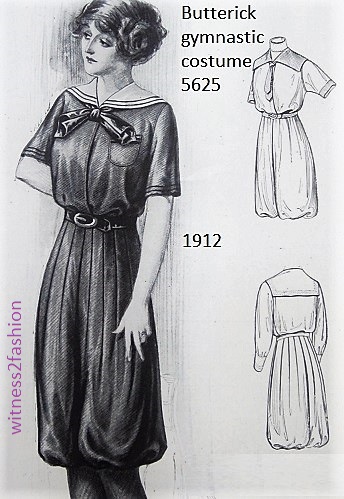
Butterick gymnasium suit 5625, from September, 1912. Delineator, p. 159.

Butterick 5625 could be made with separate bloomers and middy, if preferred.
Note her black stockings — and imagine the underpinnings needed to keep them from falling down during active sports.This time, the option to gather or pleat the bloomers is clearly illustrated:
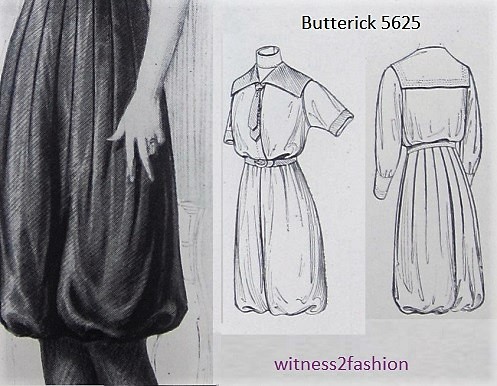
Alternate versions of Butterick 5625.

Girls who were going away to school or to college would be relieved to know that their home-made gym suit “will be entirely presentable and like the best that other girls wear.” [Unless the school required pleats, or a specific pattern or color or fabric, as schools often do.] Available in seven sizes, for girls, misses, ladies with bust measure from 28 to 44 inches.
None of these gym suits looks suitable for the kind of gymnastics women do now, but, in 1912, “We’ve got you covered.” These were also the clothes worn by American girls who took over farm work to free men for military service in 1917-18.

College students from Vassar wore their gym costumes while doing farm work.
In 1915, there was a debate over whether girls wearing gym clothes like these should be allowed to play baseball in public parks. As I wrote in a long-ago post,
“The San Francisco Chronicle runs an article every Sunday called The Wayback Machine, by Johnny Miller, who goes through ‘the archives of 25, 50, 75, and 100 years ago to bring us glimpses of the past.’ On January 4, 2015, he found this article from January 8, 1915, heralding the end of the bloomer ban:
“As far as the Park Commissioner is concerned, ‘the bloomer girls will be allowed to play ball in Golden Gate Park, notwithstanding Mrs. Grundy to the contrary. For some time these young misses have been an attraction on the park diamonds where they could be depended upon to put on a stirring game. And then Mrs. Grundy appeared on the scene and the games ceased. But now they will resume for the park Commission sees no harm in young girls, attired in their gymnasium suits, disporting on the park greens.”
When I first shared this article from the Chronicle, I wrote, “A less sexually provocative outfit would be hard to imagine. Perhaps the fact that the female baseball players’ stocking-clad legs were visible was the reason “Mrs. Grundy” objected to games in Golden Gate Park in 1915.”
Imagine Mrs. Grundy’s reaction to 21st century gymnastic costumes!
